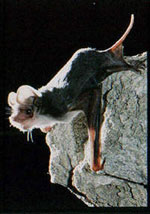
Form and Function
These bats are amazing creatures because like most bats they are nocturnal, which means they sleep for most of the day and come out at night to hunt for food. The Brazilian/Mexican free-tailed bat also is a relatively small creature that you can hold in your hand! Keep reading below to find out even more about this awesome species.
Dental studies have determined
that the longest living bat related to this species was over
eight years old. That might seem very young but the longest
living bat lived to be only twelve years old in captivity!
Tadarida
brasiliensis
is a relatively small bat, males are on average 23 mm and
females 46 mm (Wilkins, 1989).
Although they may seem small and not have a long
lifespans they do have very impressive adaptions to their
environment that help them survive. Some of these adaptions
include the development of using echolocation to communicate and
physical adaptions such as stronger muscles to control flight
speed.
Brazilian/Mexican
free-tailed bats begin foraging for food after sunset and feed all
throughout the night. These bats can fly over 50 kilometers in order
to reach a feeding area and at 3300 meters they have the highest
recorded flight altitude among other species (Sosnicki, 2012). A recent observation in a
Colorado mine discovered that these bats were most active in feeding
and searching for new roost sites in the late morning and afternoon.
It was also found that these behaviors occurred in the months of
June through September because the seasons are beginning to change
at this time. Brazilian/Mexican free-tailed bats have also been found to be
social animals and tend to live in large colonies. (Sosnicki, 2012)
 In
order to sense different stimuli and their environment these bats
use a form of echolocation as their main mode of perception.
Echolocation is a form of communication used mostly with bats but
also seen with
dolphins where the animal uses sonar in a call to
detect the distance of objects. They also use this for detecting
prey and navigation mainly because they come out at night for food
(Sosnicki, 2012). This adaption has helped the bats when flying in
the dark in order to detect prey as well as nearby objects so they
do not slam into something. Bats use this form of communication and
perception due to their poor eyesight. While adapting to hunting at
night and having to find a more adaptive form of finding food
(echolocation) bats may have began to lose their eyesight.
In
order to sense different stimuli and their environment these bats
use a form of echolocation as their main mode of perception.
Echolocation is a form of communication used mostly with bats but
also seen with
dolphins where the animal uses sonar in a call to
detect the distance of objects. They also use this for detecting
prey and navigation mainly because they come out at night for food
(Sosnicki, 2012). This adaption has helped the bats when flying in
the dark in order to detect prey as well as nearby objects so they
do not slam into something. Bats use this form of communication and
perception due to their poor eyesight. While adapting to hunting at
night and having to find a more adaptive form of finding food
(echolocation) bats may have began to lose their eyesight.
The Brazilian/Mexican free-tailed bat does
have morphological features that suggest adaptations for rapid
flight. For instance these bats have short ears that lie against the
head so they do not face the direct route air would move during
flight. Wrinkled lips around the muzzle of the bat suggest an
enlarged mouth opening for capturing
insects and food to make up for
their lack of maneuverability during high speed flight. Muscles are
also very well developed in the wing membranes to tense different
areas during flight in order to control flight speed (Wilkins,
1989). Muscles that are used mainly for flight are composed of fast
oxidative fibers which represent an adaption for high speed flight
for long periods of time. During colder months the Brazilian/Mexican
free-tailed bat shows an ability to resist hyperthermia due to an
increase of fat storage during season changes (Wilkins, 1989). When
testing different reactions to environment change it was found that
the Brazilian free-tailed bats could only survive without food and
water for one-fourth to one-third the time of other
hibernating
species. It was found that the bats could survive three to four
times longer at 27°C than other hibernating species though (Wilkins,
2012). This find could be a possibility for explaining how they can
survive such cold weather due to a mechanism of greater body-water
retention (Wilkins, 2012).